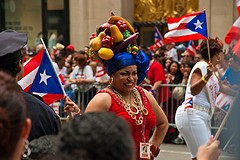THE REBIRTH OF THE NATIONAL PUERTO RICAN DAY PARADE: FROM A COMMERCIAL TO COMMUNITY EVENT
- New York, NY 06/10/2014 by Angelo Falcón (NiLP)

A reborn Puerto Rican parade marched up Manhattan's Fifth Avenue on Sunday, reflecting the cultural and political resiliency of New York City's close to 800,000 Puerto Ricans. After a year of controversy over the future of this community institution, its successful transformation from a commercial to a genuine community event is an encouraging sign that for a community viewed by many to be on the wane; that it is, in fact, capable of pulling itself together to meet today's challenges. Although much more remains to be done in this regard, fixing the National Puerto Rican Day Parade stands as a great beginning.
Miguel Cotto, Rosie Perez, Rene "Residente" Pérez, Victor Cruz, NYC Council Speaker Melissa Mark-Viverito, Congresswoman Nydia Velazquez mamboing up the Fifth, Lauren Velez, Polito Vega, NYC Mayor Bill de Blasio, New York Governor Mario Cuomo, Chicago's José Lopez, the Borinquneers, Fat Joe and many others marched up Fifth Avenue, all proudly shouting
¡Soy Boricua, pa' que lo sepa!
According to the Parade, it involved over 125 delegations, 67 floats and double the ratings for its television broadcast. Thousands of Puerto Ricans came from throughout the city, across the United States and Puerto Rico to say ¡presente!
More than a couple of observers saw this year's Parade as representing an interesting transition. At several points, whether it was their news conference in Puerto Rico and other events here, there was a bit of a language problem that many of the Parade Board members' command of Spanish was not 100 percent. But rather than a deficit, it turns out that this represented the interesting takeover, once and for all for some, of the Parade by the Puerto Rican's diaspora's second, third and beyond generations, most of whom may feel more comfortable speaking in English, but also functioning bilingually to different degrees. Up until this point, the Parade had been dominated by a relatively small first generation clique centered in The Bronx. This new transition signaled the opening up of the Parade to the broader Puerto Rican experience that had been neglected for so long by the old Parade organizers.
The problems plaguing the Parade have been well-documented this past year, so we move on to discuss what elements made it overcome those problems. In doing so, we may be able to identify ways to revitalize other institutions and actors in the Puerto Rican community in the same way.

Puerto Rican Day Parade (Flickr: John Trif)
Miguel Cotto, Rosie Perez, Rene "Residente" Pérez, Victor Cruz, NYC Council Speaker Melissa Mark-Viverito, Congresswoman Nydia Velazquez mamboing up the Fifth, Lauren Velez, Polito Vega, NYC Mayor Bill de Blasio, New York Governor Mario Cuomo, Chicago's José Lopez, the Borinquneers, Fat Joe and many others marched up Fifth Avenue, all proudly shouting
¡Soy Boricua, pa' que lo sepa!
According to the Parade, it involved over 125 delegations, 67 floats and double the ratings for its television broadcast. Thousands of Puerto Ricans came from throughout the city, across the United States and Puerto Rico to say ¡presente!
More than a couple of observers saw this year's Parade as representing an interesting transition. At several points, whether it was their news conference in Puerto Rico and other events here, there was a bit of a language problem that many of the Parade Board members' command of Spanish was not 100 percent. But rather than a deficit, it turns out that this represented the interesting takeover, once and for all for some, of the Parade by the Puerto Rican's diaspora's second, third and beyond generations, most of whom may feel more comfortable speaking in English, but also functioning bilingually to different degrees. Up until this point, the Parade had been dominated by a relatively small first generation clique centered in The Bronx. This new transition signaled the opening up of the Parade to the broader Puerto Rican experience that had been neglected for so long by the old Parade organizers.
The problems plaguing the Parade have been well-documented this past year, so we move on to discuss what elements made it overcome those problems. In doing so, we may be able to identify ways to revitalize other institutions and actors in the Puerto Rican community in the same way.
To continue reading, visit: http://campaign.r20.constantcontact.com/render?ca=6f8c1f3b-ee61-4505-970c-6b24c15438dc&c=78f95eb0-32a8-11e3-8845-d4ae52753a3b&ch=7a465110-32a8-11e3-88d9-d4ae52753a3b